- Live In The D
- Newsletters

The secret city beneath our feet: Inside Detroit’s epic salt mines
The history of the detroit salt mines.
Morgan Russ , Digital News Editor
DETROIT – If the residents of Detroit ever tried to dig a hole to China like I did when I was a kid, you probably wouldn’t have made it to China, but you might have eventually reached the secret salty city below the streets of Detroit.
ClickOnDetroit readers frequently submit questions about the salt mines through our 4YI form , so we decided to take a deep dive into the epic salt mines below our feet.
Recommended Videos
According to the Detroit Salt Company , 400 million years ago, ocean water flooded into a large basin, an area known as the Michigan Basin. As the water evaporated it left behind large deposits of salt. These deposits were covered by dirt that was pushed by glaciers over the years. All of you sciencey folks out there, the Salt Company says this: “The basin was an arid area of Michigan’s lower peninsula separated from the ocean by a natural bar of land. As the basin continued to sink lower into the earth, salt-laden ocean water repeatedly poured into the depression, where it gradually evaporated, forming miles of salt beds.”
Related: Giant whipped cream cans in Dearborn: The history and where they are now
The salt rock was first discovered in 1895. The only issue is that the deposits were located beneath hundreds of feet of stone and glacial drift. By 1906, the Detroit Salt and Manufacturing Company was ready to do, what seemed to be, the impossible.
Construction crews had consistent challenges come their way. Aside from the stone and glacial drift, there was also the presence of hydrogen sulfide gas. Six men were killed during the dig. This endeavor would ultimately bankrupt Detroit Salt and Manufacturing Company before reaching the buried treasure.
Detroit Salt reports that the company was eventually reorganized and able to finish the 1,060-foot shaft in 1911 with their new name, Detroit Salt Company. Two years later, with new management, the Watkins Salt Company, the company was able to sink the shaft another 100 ft. and miners were able to begin work on a second salt bed.
Productivity significantly improved, so much so that their competitor International Salt Company began to notice their success. To maintain their hold on the Midwest, the company strategically purchased the Detroit mine.
Related: It’s no myth: The story of the elephant buried at former Waterford mall
By 1914, the mine was producing 8,000 tons of rock salt each month. The salt produced was mostly used for leather and food processing industries. New technology only pushed the mine further as physical demands of miners were reduced. More mine workers, more money, electric locomotives, mechanical shovels, and electric power were the keys to continued success.
In 1922, Detroit Salt explains, the company began to dig a deeper and larger second shaft. The goal was to increase the rate of hoisting rock salt to the surface. Within three years the second shaft was in operation. Due to narrow shaft openings, all of the machinery had to be lowered down piece by piece and reassembled once inside.
The mine remained in use until 1983, when International Salt closed the doors. Two years after the closure in 1985, Crystal Mines Inc. purchased the mine as a potential storage site. However, in 1997, the Detroit Salt Company, LLC, bought the mine back from Crystal Mines and began salt production in the fall of 1998.
Related: What happened to the big stove next to entrance of State Fair in Detroit?
Although the salt was used in leather production and food industries, road salt is currently the only product the mine provides.
In 2010, The Kissner Group purchased the Detroit Salt Company, LLC and the Detroit Mine, Detroit Salt says. Both companies now work together to provide the continent with a line of ice-melting products.
With the latest mining techniques, the mine is one of the safest, modern, and efficient mines in the world.
While many remember touring the salt mines decades ago, they are no longer available due to safety regulations. Try not to be salty about it.
Fun fact: the Detroit salt mines are featured and can be viewed in MINILAND Detroit, a Lego display with replicas of loved landmarks from Detroit at Legoland Discovery Center in Great Lakes Crossing.
Do you have a memory of touring the salt mines? Let us know in the comments below.
Copyright 2023 by WDIV ClickOnDetroit - All rights reserved.
Click here to take a moment and familiarize yourself with our Community Guidelines.
- Grand Rapids/Muskegon
- Saginaw/Bay City
- All Michigan
Detroit's salt mines are Michigan's biggest buried secret
- Published: Jul. 28, 2017, 1:00 p.m.
- John Serba | [email protected]

The Detroit Salt Company (MLive photo | Ben Solis)
By John Serba | [email protected]
It’s called “the city beneath the city”: the myriad tunnels and chambers of the Detroit salt mines comprise one of our great state’s man-made marvels, a true thing of fascination for Michiganders. Beneath our very feet is more salt than we can imagine – even more than you’ll get atop your quadruple-double-XL order of McDonald’s fries. Way more.
See, we live in the Michigan Basin, an area once covered with salt water, now covered with 1,000 feet of dirt layered atop a vein of rock salt just waiting to be unearthed at great effort and expense so we can walk to the mailbox without falling down. Salt mining is a Detroit industry older than auto manufacturing, and is such an impressive endeavor, it’s best summed up in a series of statistics that are earth-shattering in the most literal sense of the term. Here are the Detroit salt mines, by the (really, really big) numbers.

The U.S. salt bed map (Courtesy photo | U.S. Dept. of Energy)
400 million
Age of the salt deposit, in years. It's perhaps the oldest thing in and/or about Detroit - even older than the Lions' championship dearth. Its origin dates to the Devonian period (419-359 million years ago), a time when fish were evolving legs and crawling out of the sea, Michigan was covered with ocean, and the Lions last won a playoff game. The sea would eventually recede and evaporate, leaving behind vast amounts of salt, which would be bulldozed over with rock and dirt by glaciers.
Years that have passed since the salt was discovered. Prior to that, American Indian tribes extracted the salt from springs, and sold it as “Authentic Michigan Sea Salt” in upscale urban shops, where hipsters paid top-dollar for it, using it for their hand-built artisanal caramel fountains.
Length, in feet, of the original mineshaft. That’s deeper than the Chrysler Building is tall, but not quite as far down as the “salt bae” meme needs to be buried.
Number of workers who died digging the shaf t. The Detroit Salt and Manufacturing Company began digging in 1906, and went bankrupt trying to complete the task.

Mackinac Bridge (MLive file photo)
Year the shaft was finally completed, by the Detroit Salt Company. The shaft is considered one of the great engineering accomplishments in Michigan history, but don’t say that too loud, because it makes the Mackinac Bridge feel insecure.
Size, in feet, of the opening to the shaft at the time . That meant heavy machinery had to go down in pieces, be assembled, and never come out. Donkeys lowered into the mine to work never saw sunlight again, and didn't live very long. "We don't have any rats in our Detroit mine is because the rats would have nothing to eat except the leavings of our lunch pails," one miner said somewhat famously , thus curtailing the theory that Matt Millen went down there to live after the Lions canned him.
Year digging of a second shaft began. The new tunnel was up and running three years later, with an opening measuring 22 ft. wide .
Amount, in tons, of salt yielded from a single dynamite blast . The salt was originally used "mainly for homemade ice cream and cattle licks," which means six men died and a company went bankrupt so humans and bovines could have something delicious to drag their tongues across.
Years the salt mine was abandoned, from 1983-1998. The economy of salt mining dried up like a 400 million-year-old ocean, prompting the company at the time, International Salt, to say, “Na.” Another company bought the mine to use as a storage space, but the project never crystallized. When it all shook out, the Detroit Salt Co. purchased the mine in 1997 and started business up again.
71 trillion
Approximate amount of salt, in tons, remaining down there, even after 100 years of mining. Detroit Salt produces 1.7 million tons of salt annually, and will increase to 2.5 million tons if a proposed expansion is approved . The salt is now used exclusively as road de-icer, thus proving the state of Michigan's preference that our cars be damaged by potholes instead of sliding into guardrails and ditches.
Acreage of the vast network of underground tunnels. Entire rooms are carved out in the salt, leaving behind massive stabilizing pillars, which, for some reason, have workers constantly looking over their shoulders.

MLive file photo | Rachel Sonnenshine
Miles of roads in the tunnels, which stretch from Dearborn to Allen Park. Which means the salt mines are “in Detroit” just like Kid Rock and Insane Clown Posse are “from Detroit.”
Tours of the mine currently being offered. Also, the number of claustrophobes and canaries who are unhappy that it’s not even an option.

MLive file photo
More Michigan life and culture
The 5 most ridiculous things about Michigan's state flag
12 wild and weird facts about the largest fish you can catch in the Great Lakes
The historic futility of the Detroit Lions: a very sad timeline
8 fascinating facts about Iron Mountain, Tom Izzo's hometown
Torch Lake is Michigan's own slice of the Caribbean
A guide to the 9 drive-in movie theaters still standing in Michigan
This Northern Michigan drive-in movie theater is a nostalgia trip
6 places to sip a Michigan beer along the White Pine Trail
These three Hollywood movies filmed at the same Niles train station
Use of and/or registration on any portion of this site constitutes acceptance of our User Agreement (updated 4/18/2024), Privacy Policy and Cookie Statement , and Your Privacy Choices and Rights (updated 12/31/2023).
© 2024 Advance Local Media LLC. All rights reserved ( About Us ). The material on this site may not be reproduced, distributed, transmitted, cached or otherwise used, except with the prior written permission of Advance Local.
Community Rules apply to all content you upload or otherwise submit to this site.
YouTube’s privacy policy is available here and YouTube’s terms of service is available here .

Detroit Salt Mines
Introduction.
Text-to-speech Audio
Detroit Salt Mine Formation
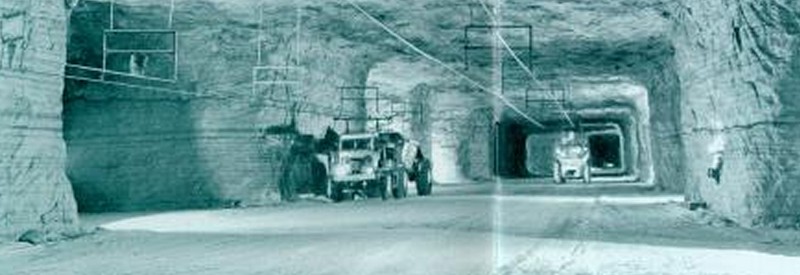
The shafts leading into the mines. Reuther Library/Tony Spina
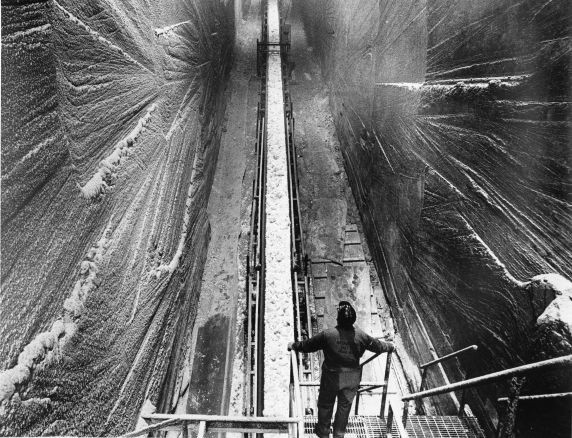
Large salt rocks within the mine
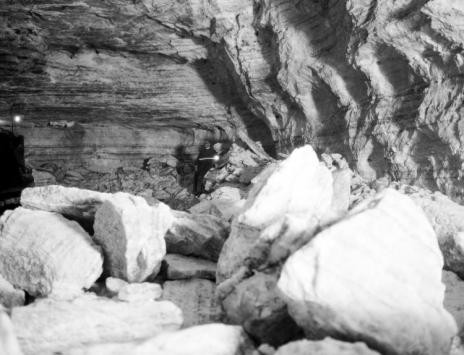
Mine employees
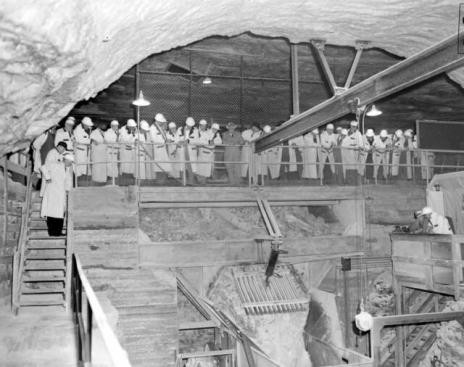
Backstory and Context
Creation of salt underneath the city of detroit.
The salt deposits underneath Detroit, spreading from north of Allen Park, underneath Dearborn’s Rouge, and covering most of Melvindale, were formed nearly 400 million years ago during the Devonian Period. It was a time when the first fish were evolving to grow legs to make their way onto land; the first seed bearing plants were coming into existence. Also, the area known as the Michigan Basin was separated from the ocean, and it was sinking lower and lower into the Earth’s crust. Salt water poured into the Basin, gradually over many years, until the oceans receded. The saltwater soon evaporated, leaving behind huge salt deposits.
Glacial activity led to the formation of the Niagara Escarpment, a large basalt rock area covering most of Wisconsin and Michigan, burying the salt deposits. The Great Lakes sit atop the basalt rock, and below, nearly 1,200 feet, the salt deposits remain as the largest known salt deposit in the world with over an estimated 71 trillion tons of unmined salt. 1
History of Salt Mining in Detroit
Native American tribes were historically known to filter and gather salt in the Detroit area from the various salt springs, but the first official discovery of the enormous salt deposits is credited to the year 1895. Despite the discovery, however, the salt deposits were over a thousand feet beneath stone and glacial drift, and getting to the salt turned out to be a deadly endeavor, with six men dying during the dig. The Detroit Salt and Manufacturing Company, the first to try and capitalize on the deposits, went bankrupt in the process.
By 1910, after the construction of a 1,060-foot shaft, extraction of the salt finally began. Objects lowered into the mines were destined to stay there forever, including the mules used to carry the extract salt. Four years later, under ownership of the International Salt Company, the Detroit mine was producing nearly 8,000 tons a month, and with the help of electric locomotives, mechanical shovels, and electric power, productivity was booming.
Then in 1922, to meet growing demand, International Salt dug a second shaft to accommodate greater manpower and machinery, and most of the machinery used at that time is still in the mines today. Salt mining continued until 1983, when International Salt closed the mines. In 1997, Detroit Salt Company LLC bought the mines and began mining once again for the road salt industry.
Today, the Kissner Group owns the mines, which now span over 1,500 acres with 100 miles of tunnels beneath Detroit, and the mine is considered to be the safest, most efficient in the world. 2
Additional Information
- Detroit Salt Co. Official Website
- "The vast, abandoned salt mines that lurk beneath Detroit," published by i09
- Time Magazine article on the mines

- New Releases
- Author News
- Our Bloggers
Wednesday, June 10, 2015
The detroit rock salt mine, the history of the detroit rock salt mines..
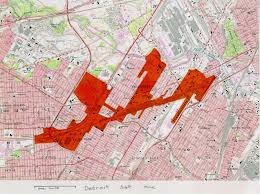
Interesting post. I do not know anything under the city of San Diego, but we are going to Seattle this week for vacation and hope to tour the underground city there under the HistoricTown area. sm wileygreen1(at)yahoo(dot)com
- Restaurants
- Development
- The Way It Was
- Film & TV
- Things to Do
- Fitness & Wellness
- Hour Media Events
- Partner Events
- Photography Request Form
- Best of Detroit
- Excellence in Care
- Company Milestone Profiles
- Faces of Detroit
- Top Docs Event
- Give Detroit
- Great Places
- Canna-Business
- Women Who Move Detroit
- Parents’ Guide to College
- Professionals
- Other Publications
- Digital Edition
- Purchase Single Issues
- Newsletters
- Where to Find

Detroit’s Salt Mine

1923 If you doubt that metro detroiters are “the salt of the earth,” just look down — about 1,200 feet. In the city’s cellar are more than 1,400 acres of a salt mine, remnants of what was a sea millions of years ago. The men wearing headlamps here are using pickaxes to hack at salt rocks. The mineshaft’s opening is on Sanders Street on the west side of Detroit, and the maze runs beneath Dearborn’s Rouge complex, Melvindale, and Allen Park. Opened in 1896, the mine was operated for years by the International Salt Mine Co. until 1983, when it closed. But the mine reopened in 1997, when the Detroit Salt Co. assumed ownership, supplying Michigan and other states with rock salt to melt hazardous ice on winter roadways. In 1940, Detroit became the first major city to use rock salt to control snow and ice.
RELATED ARTICLES MORE FROM AUTHOR

Best of Detroit 2024

Study Breaks: Intriguing Findings From Researchers Across Michigan

Local Landmarks: Southfield’s Favorite Patriotic Elephant
Newsletters.

FROM OUR PARTNERS

Bowlero Lanes & Lounge in Royal Oak highlighted in...

The Fourth Up North

Spectacular Vision
- Terms & Conditions
- Privacy & Cookies Policy
- Hour Media Corporate

Detroit Salt Mine: The hidden gem beneath our city.
By: metro detroit chevy dealers | october 8, 2012.

I’ve always been fascinated with salt. Laugh away, but it has an incredible history! Civilizations expanded and progressed in the quest for this amazing spice. Opposing militaries used it as a weapon of war, salting the fields to spoil land for crops. In ancient China, they used salt as currency. There isn’t a point in time when salt wasn’t important.
This is why it’s so exciting to me that Detroit has a massive working salt mine that stretches 1,500 acres from Dearborn to Allen Park . The mine shaft itself is 1,160 feet straight down and there are more than 100 miles of roads connecting the different areas of the mines. It’s an entire city beneath a city!
Rock salt was discovered in Detroit in 1895, but it wasn’t until 1906 that the Detroit Salt and Manufacturing Company began the arduous task of digging a shaft to create a mine. Despite many challenges, a bankruptcy and business reorganization, the shaft was completed by the newly named Detroit Salt Company.
In 1912, under the name Detroit Rock Salt Company, crews began work on a second salt bed. The new operation improved productivity and rock salt purity, which caught the eye of the International Salt Company who acquired Detroit Rock Salt in order to keep their edge on the marketplace. By 1914, crews began to utilize “modern” technology in the form of electric power, mechanical shovels and electric trains to help keep up with production needs, to the point that it was producing up to 8,000 tons of rock salt each month.
From transporting food and goods to having enough room for pets and family, owning the right SUV is essential for pet owners. See the available features that make the Chevy Tahoe a pet lover's dream.
With the demand for salt steadily increasing, the company recognized a need for a larger, second shaft and began to dig in 1922. By 1925, crews had completed the work and began using it to haul more rock salt to the surface. Crews continued to mine the rock salt until 1983 when production costs began to exceed salt prices, and International Salt halted operations. In 1997, Detroit Salt Company purchased the mine and began production again, which continues to this day.
And while it’s awesome to think that this mine has been operating virtually non-stop for the past 100 years, without fatalities or a collapse, there are other facts about the mine that are even more mind-blowing!
For as large as the mine is, you can imagine that the equipment needed to blast the salt and haul it around needs to be just as large. And getting it down those narrow shafts isn’t an easy feat. Typically, the equipment like trucks, machinery and jeeps, are disassembled, lowered down piece by piece and reassembled in the mine’s shop area. Then, once down in the mine, it stays there.
Another interesting fact is that if the mine shaft were a building, it would be second only to the Empire State Building which is 1260 feet tall, compared to the shaft’s “measly” 1160 feet. And, thanks to the depth, the temperature stays about 60 degrees year round. Perfect weather, if you can get over the fact there’s no sun.
But the greatest thing I find about the salt mine is the fact that you’d never know how big the mine is or how much goes on under our feet on a daily basis just by looking at the entrance to the mine. It’s sort of a metaphor for Detroit, isn’t it? There’s more to us going on than you think. Don’t take our city at face value. Sometimes you gotta dig a little deeper to get to the stuff that matters. And in this case, it’s salt.
To see some really great images, The Detroit News has an incredible archive of images from the mines first days, as does Environmental Graffiti.

RELATED STORIES

Savor The Season: Berry-Licious Treats

Rooftop Rendezvous: Metro Detroit’s Best Outdoor Bars

Detroit’s Donut Delights Can Sweeten Your Day

Want EXCLUSIVE In The D content?
Subscribe to our newsletter..

SIGNUP FOR A RELATED STORY!
Copyright © 2010 International Ship Masters' Association Detroit Lodge No. 7, Inc. All Rights Reserved
The vast, abandoned salt mines that lurk beneath Detroit
Over 1,000 feet beneath the city of Detroit is a 1,500 acre sprawl of tunnels created by salt miners at the turn of the twentieth century. Over at Environmental Graffiti, there's a fascinating story about the rise and fall of Detroit as the great city of salt production. Discovered in the late nineteenth century, Detroit's salt deposits would prove lucrative — but only to the company with the engineering capabilities to actually drill down far enough to reach it.
As Environmental Graffiti's Simone Preuss explains:
The Detroit Salt and Manufacturing Company operated the mine until 1983 but then falling salt prices forced the mine to stop production. In its heyday in the 1920s, 1940s and ‘50s, the mine was open to the public with guided tours – a popular educational trip for school classes. Today, the entrance to the mine at 12841 Sanders Street is only for delivery trucks and public tours have not been conducted since the 1980s.
Related Content
One of the many problems with working in such a deep mine was that equipment had to be lowered down the narrow shaft in pieces, then assembled at the bottom. Even donkeys were lowered down to work, and never brought back up.
Out of commission for many years, the mine was bought in the late 1990s and is now used mostly to produce rock salt. Here's hoping the new owners, Detroit Salt, will open it for tours again.
Read more, and see more pictures, at Environmental Graffiti
Images via Wayne State, Detroit Salt, and University of Michigan
Berchtesgaden Salt Mines
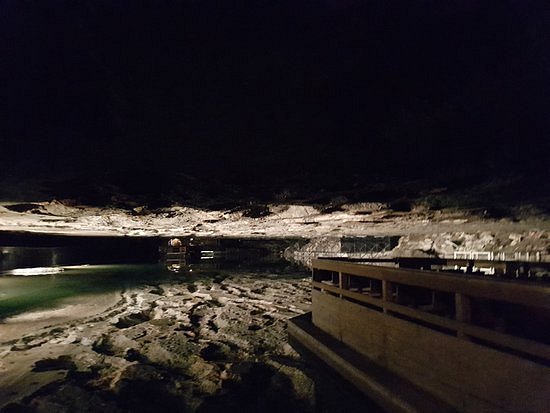
Most Recent: Reviews ordered by most recent publish date in descending order.
Detailed Reviews: Reviews ordered by recency and descriptiveness of user-identified themes such as wait time, length of visit, general tips, and location information.

Also popular with travelers

Berchtesgaden Salt Mines - All You Need to Know BEFORE You Go (2024)
Detroiters get 1st look inside revived Michigan Central Station during tours
Detroiters on Friday get their first look inside revived Michigan Central Station after Thursday's blowout opening night concert .
Visitors, who had to sign up in advance for tours for the Detroit train station, will encounter a range of activities and exhibits honoring the station's history and six-year restoration. Tours continue daily through June 16, but they are fully booked. The station will be open for self-guided tours on Fridays and Saturdays through August.
The first floor of the station, by then with some shops and other features expected to be built out, is scheduled to be open to the public in September.
Follow along here to experience Detroiters' first steps inside the renovated station.
Michigan Central Station tours: How to visit Ford's renovated train depot
3:40 p.m.: A job loaded with smiles
John Martin is a new Michigan Central ambassador, after making a career out of cable TV advertising and spending a couple of more years working part-time gigs. Friday was just his second day of work after he snagged the job just in time for the station’s reopening.
Martin grew up in Lincoln Park and later worked in downtown Detroit, so he spent most of his life watching the city up close.
“Being that I worked down here, I’ve always been interested about what’s going on in the city, and that never left me even after I found another job,” he said.
He toured Michigan Central’s open house back in 2018 after it was acquired by Ford and has since been stunned by Detroit’s numerous and gorgeous renovations.
After he stopped working one of his part-time jobs earlier this year and almost simultaneously came across the Michigan Central ambassador position, he knew he could take the job and have a good time with it.
Martin stands at the doors of the Grand Hall and greets people as they enter with smiles widening and eyes lighting up at their first sight of the hall.
“One of my jobs that I didn’t do this year after working it for 12 years was at a golf course … You get a lot of interaction with folks. You’re not always putting out fires, but there always seems to be one on your shift. So, I thought, jeez, I could come in here and how many fires could I have? People are coming in here awestruck, they’re not complaining,” he said.
3 p.m.: Streets around train station returning to normal
By Friday afternoon, Michigan Avenue opened to vehicles after being closed for Thursday's opening festivities, and there was no traffic congestion even as thousands of people descended on the train station for the first day of public tours.
As workers outside continued to dismantle the concert stage, about 1,800 visitors walked through the train station as of 3 p.m., Michigan Central spokesperson Dan Austin said.
A total of 5,000 visitors were expected Friday, with tours ending at 10 p.m., he said.
1:55 p.m.: Details make the difference
Christina Roki of Sterling Heights, and Grant Sloan of West Bloomfield, two automotive content creators who were invited to opening day by Ford, said they were brought to tears by the stories preserved inside Michigan Central Station.
“What we appreciate about it most is how much detail Ford cared to preserve to show the story. They kept part of the graffiti on the walls, they preserved a lot of the tickets they found … Even the brick, all the chisels we see on the brick, they didn’t try to make fine cut lines, they still want to show all the history that this building has,” said Roki.
As their tour guide led from room to room in the building, they remained at a loss for words.
“The inside was literally mind-blowing. I feel like I was walking in on such a big piece of history that’s been preserved for so long, so it’s crazy to think that this is something they’ve been working on in the past few years,” said Roki.
But for the two metro Detroiters, one of the most significant parts was just to see how Michigan Central had been given new life, narrowly dodging demolition. Sloan remembered times passing by the station with his friends just before the renovation began to see the graffiti and decay; now, to see that part of modern history meshed with its historical past, he said to step inside the new shiny floors was an awesome experience.
“Any Detroiter will agree that this building was such an eyesore for such a long time. Growing up in Detroit and knowing its history but never seeing it operational… But now seeing it up in running, it’s really touching to see that Ford took on such a large project,” said Sloan. “It’s early but I think it’s safe to say that the investment already paid off.”
— Kylie Martin
1:45 p.m.: Returning soon
Southwest Detroit resident Jennifer Serra set an alarm in hopes of scoring tickets to see the train station on its first day of public tours.
“There's just not enough wonderful words to describe it,” Serra, 45, said after securing tickets and touring the station Friday.
The only problem? She had somewhere else to be this afternoon and wanted to spend more time in the station. She’s already made plans to come back for another tour in a few days.
“I feel like it's like a symbolic representation of what goes on in our city,” she said of Michigan Central Station. “I feel like there's just these landmarks in certain cities … that just really kind of embody the overall history of what's going on. I feel like this helps us bring a little bit of closure to some tough times and show renewal.”
— Adrienne Roberts
1 p.m.: 'Another crown jewel'
Tom Schultz and his wife, Sylvia Ross-Schultz, are both born and raised Detroiters, but more than that, they’re Detroit-lovers.
“We’re so glad to see it getting so much better, and it’s beautiful … It’s just in my heart, it’s been the neatest thing,” said Ross-Schultz. “It’s another crown jewel in the renovation of Detroit.”
“I made the statement, and I was wrong, that (the comeback) would never happen in my lifetime,” said Schultz. “The rebirth is off the charts.”
Remembering the good old days of Michigan Central Station in the 1970s, the couple knew they had to tour the station on opening day, and so did Ross-Schultz’s cousin and her husband, Renee and Tom Toft. With ancestors who worked in the building, the families are woven into the fabric of Michigan Central, as well as the city of Detroit.
Additionally, the Tofts took what they called the “falling apart” tour of the station back when Ford purchased it in 2018.
Now, the four stood waiting for their tour in awe at the renovated front of the building.
“Instead of just knocking it down, to bring it back to this grandeur is absolutely fantastic,” said Ross-Schultz.
“You see the work they did out here, they recreated everything the right way,” said Tom Toft. “It’s spectacular. We haven’t even gone inside yet but I know its going to be spectacular.”
12:40 p.m.: Eager to return
Donny Wilson and his brother Paul Wilson had never been inside the train station until Friday morning, but they’re all ready to come back.
Donny Wilson, 41, an influencer who lives in Oak Park, wants to bring his family and friends to the station to see it.
“I can't wait until all this stuff is actually in there …the shops, hotel …” Donny Wilson said after touring the station.
Paul Wilson, 42, a Detroit resident, said he’s just thought of the station as a ruin his whole life — until now. “It’s so cool how they refurbished everything and still kept a whole lot of the building intact,” Paul Wilson said.
Noon: 'Berliners are obsessed with Detroit'
NPR reporter Bobby Allyn, 35, walked quickly toward Michigan Central Station as he prepared to interview President Joe Biden’s director of the White House Office of Science and Technology Policy, Arati Prabhakar, at Newlab on Friday. He said he was super excited to be in Detroit, having heard so much about the city when he lived in Berlin.
“Berliners are obsessed with Detroit because of techno music,” Allyn said. “It’s the birthplace of techno. Look up Jeff Mills of Detroit and techno. You’ll see. When you go to Club Berghain in Berlin, it’s impossible to get in but if you wear a hat that says, ‘Detroit,’ they let you in.”
Allyn, a technology correspondent , reports on startups, artificial intelligence, privacy issues and tech litigation. While he was directed to the building next door to Michigan Central Station, the whole site is part of the mobility hub led by Ford Motor Co. Allyn said he couldn’t wait to see the inside of the restored train depot after the interview.
— Phoebe Wall Howard
11:50 a.m.: Memories rekindled outside Michigan Central
Bob Bilkie, 63, and Shari Bilkie, 62, of Northville walked the side streets surrounding Michigan Central Station as they waited for the noon public tours to begin. They parked at 10 a.m. and took in the sights of the Corktown neighborhood on the cool, cloudy day.
As they approached their 41st wedding anniversary on Monday, they talked about dates at Lafayette Coney Island in Detroit, ordering their lemon meringue pie and Faygo Red Pop. That’s pretty much all Bob Bilkie could afford as an intern at Detroit Edison. At lunch, he ordered coney dogs with lots of onions and mustard because that’s what he could afford. Now Bob is an investment adviser and Shari is a compliance officer for a financial firm.
Being in Detroit together during this special time also celebrates memories of their families. Her grandfather went to Cass Tech High School and owned Ward’s Bar in Dearborn. They went to the old Tiger Stadium around the corner as a family. His father worked at American Motors as a fabricator, and his grandfather worked for the railroad.
“He probably worked here,” Bob said, glancing up at the 18-story Beaux Arts-style building from the corner of Wabash and Marantette.
Shari said smiling, “It is so cool, the fact that they took something decrepit, falling apart, an eyesore and turned it into something absolutely beautiful.”
11:35 a.m.: The morning after and a new dawn
On a much noticeably cooler and windier morning compared with Thursday, Corktown appeared to be just waking up after last night’s celebration.
With much of Michigan Avenue still closed off to vehicles Friday morning, the few businesses that were open had just a couple of customers.
The train station, however, was bustling with activity, albeit a different kind of energy compared with Thursday night, as workers dismantled the concert stage that the night before featured acts including massive music concern in Roosevelt Park a night earlier that featured Diana Ross, Eminem, Jack White and Big Sean.
— Adrienne Roberts
11:25 a.m.: Michigan Central prepares for company
The sounds of Motown and techno music filled the halls of Michigan Central Station, spilling from speakers in a gallery plastered with vintage posters less than an hour before the doors officially opened to visitors on Friday.
Inside the station, hundreds of workers dashed about, putting final touches on exhibits scheduled to attract 60,000 people over 10 days.
A woman from Chicago leading a group of eight South Korean government officials, walking through the renovated station half an hour before the official open, explained that the visitors oversee small- and medium-sized businesses and they’re looking at the 30-acre innovation zone created by Bill Ford, executive chair of Ford Motor Co.

- PHOTO GALLERY
Get Lost in the Dark Beauty of a Russian Salt Mine
Sylvinite is mined for its potassium-bearing salt, but it also has an aesthetic appeal.
The words “Russian salt mine” don’t usually make you think of stunning images. Unless, of course, you’ve seen a sylvinite mine.
Sylvinite is a mixture of rock and potassium-bearing salts, and its vibrant colors make the walls of this mine in Berezniki look like they’ve been covered in elaborate tapestry.
The rock-salt mixture has been found on every continent except Australia and Antarctica. The deposits are in places that millions of years ago were covered by seas and oceans that left behind layers of salt.
The potassium in sylvinite has been a popular addition to fertilizer since the 19th century and has had huge effects on the global food trade. Potassium makes the skin of some fruits thicker, and without it, many mangoes and bananas wouldn’t survive being shipped overseas.
Follow Becky Little on Twitter.
These photos were originally published in the Russian edition of National Geographic magazine .
Related Topics
You may also like.
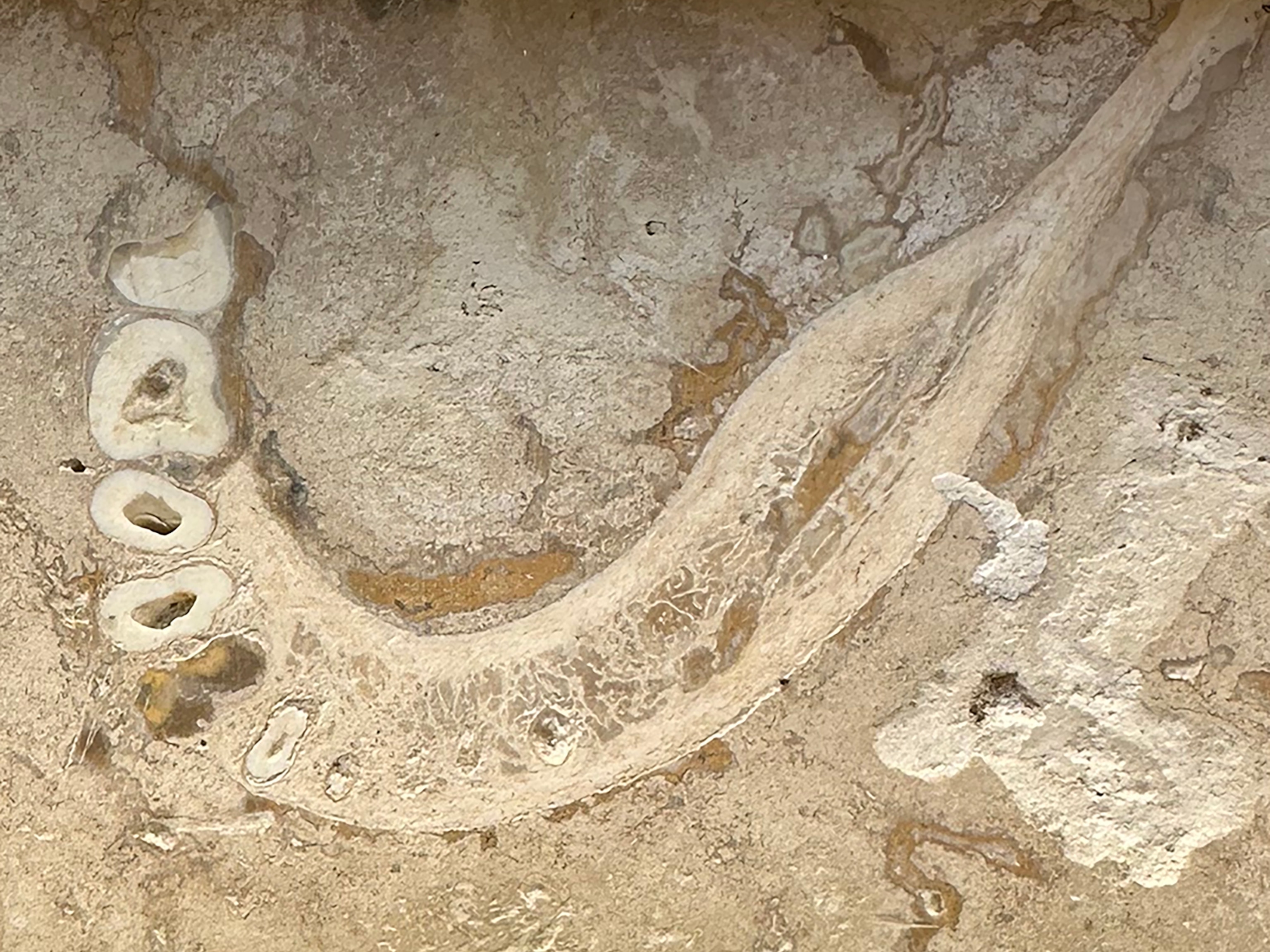
Your tile floor may contain human fossils

Are synthetic diamonds really better for the planet? The answer isn't clear-cut.

The gas in this exploding mine is odorless, colorless—and could transform the world

How to buy crystals that don’t harm people or the planet

Lithium batteries power your world. How much do you really know about them?
- Environment
- Paid Content
- Photography
History & Culture
- History & Culture
- History Magazine
- Mind, Body, Wonder
- Terms of Use
- Privacy Policy
- Your US State Privacy Rights
- Children's Online Privacy Policy
- Interest-Based Ads
- About Nielsen Measurement
- Do Not Sell or Share My Personal Information
- Nat Geo Home
- Attend a Live Event
- Book a Trip
- Inspire Your Kids
- Shop Nat Geo
- Visit the D.C. Museum
- Learn About Our Impact
- Support Our Mission
- Advertise With Us
- Customer Service
- Renew Subscription
- Manage Your Subscription
- Work at Nat Geo
- Sign Up for Our Newsletters
- Contribute to Protect the Planet
Copyright © 1996-2015 National Geographic Society Copyright © 2015-2024 National Geographic Partners, LLC. All rights reserved
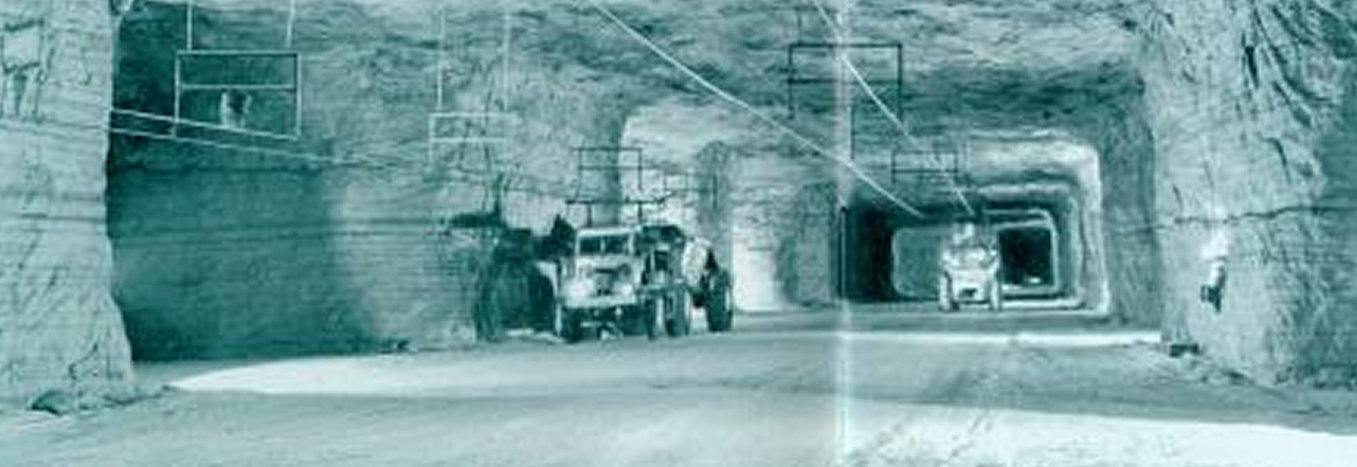
Detroit Salt Mine Formation
How did the salt get there in the first place?
Michigan, in geologic terms, is a basin - a large area of lower elevation than surrounding areas. 400 million years ago, scientists believe this area was filled with salty sea water, much like the Great Salt Lake in Salt Lake City, Utah.
Through several climate changes, a process of layering began, leaving deposits of salt and other minerals behind in Michigan.
These salt deposits were covered with other sediments over several millions of years, forming alternating layers of rocks.
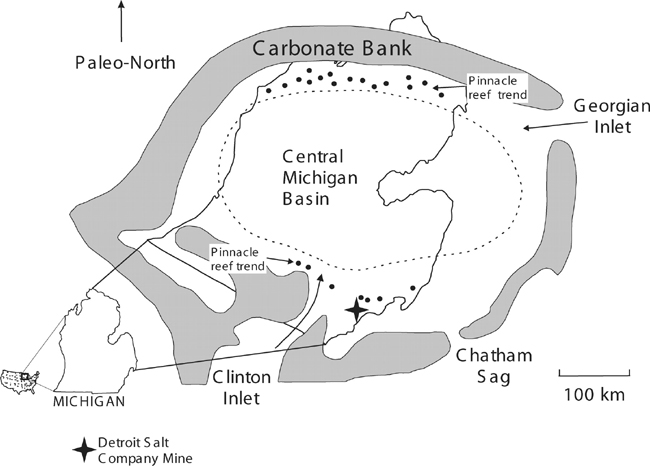
Detroit Salt Company
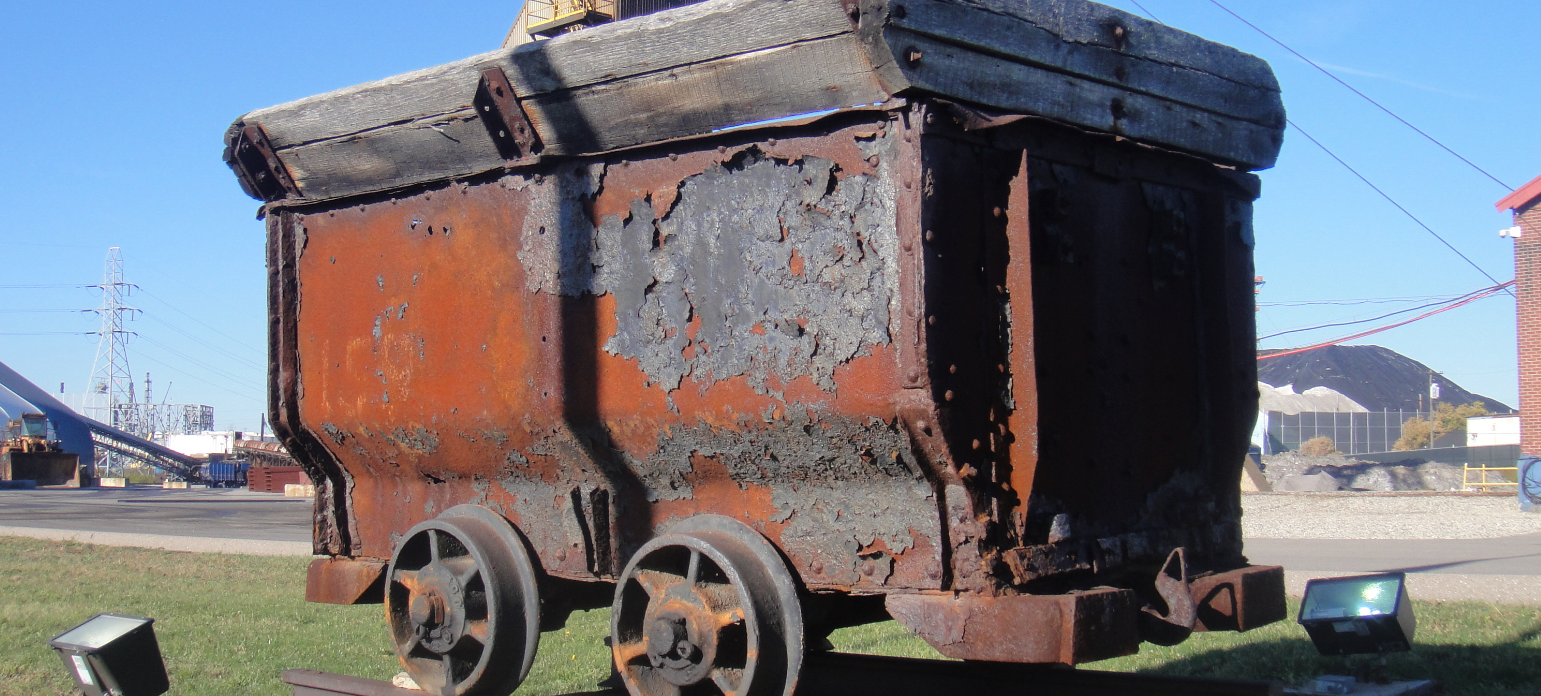
'It's stunning': Awestruck visitors get first look at restored Michigan Central Station

Detroit — The first members of the public got a look inside the restored Michigan Central Station on Friday, and they were suitably awestruck by the transformation of the towering landmark that's been rescued from ruin.
It was the entrance into the Grand Hall when the emotion hit most guests, with gawkers mouthing "wow" as they gazed up at the Guastavino tile ceilings and down at the shiny marble floors.
Rita Martuscelli, 90, of Troy was first through the station's side doors. She couldn't help but get emotional as she entered the Grand Hall, hand over her agape mouth with eyes wide as she took in the replaced soaring windows and recreated light fixtures.
"It's stunning," she said. "They're finally realizing something like this is worth saving."
In a throwback to the station's glory days, when travelers passing through wore their Sunday best, many attendees dressed up in their fanciest attire for photographic moments. Others displayed Detroit pride in Lions jerseys, vintage automotive apparel or Corktown hoodies.
Gasps could be heard as visitors entered the Grand Hall, and as they gazed at the white marble clock looming over the restored ticket booths.
Clark Haddock, 70, was nearly brought to tears seeing the clock at the end of the east entrance hallway.
"It makes me think of my Grandpa Harry, who was a jeweler here in Detroit who would take the 7 p.m. train every Christmas Eve, and we would wait for him in Kalamazoo," said Haddock, who lives in Oakland County's Beverly Hills. "I don’t think you really understand what’s possible until you see this."
Mario Muscat, a lifelong resident of Corktown who uses a wheelchair, said the tour brought back memories from his youth.
"I can see this station from my porch. I went to school at St. Vincent's, and we used to hang here quite a bit, even as a teen. We would sneak out of class and smoke cigarettes in the tunnel way. We were young and dumb. It brings me back," said Muscat, 65. "It’s finally happened ... that’s the main thing. I’m glad to see it wasn’t torn down."
His hope is to see trains roll into the station once more, as they did from its opening in 1913 until Amtrak ended service in 1988. "We used to jump on the train to Chicago in the '70s two to three times a year ... a time when we were young, and we took care of ourselves. I'd like to see that happen again."
Visitors on Friday worked their way through a circular layout on a self-guided tour, starting with a video overviewing the history of the station on a 5-foot-by-15-foot LED cube in the former women's waiting room. They applauded as it promised a bright future for Corktown and the city.
Looking over a long, sculpture timeline of the train station's history in the Grand Hall, attendees shared memories, and noted Detroit-centric facts like Houdini's death in 1926 or that the Davison Freeway was the first urban, below-grade expressway in the United States when it opened in 1942.
The attention many visitors paid to the timeline was important to Michigan Central CEO Joshua Sirefman.
"It's moving," he said, to see the building start to come alive with the community. "We asked, 'How do we add things and tell the story without taking away from the glory of the building itself?' It's humbling."
'The revitalization of Detroit'
About 60,000 people claimed free tickets for 10 days of public tours of the 1913-built depot that closed in 1988 and has undergone a six-year renovation as a part of a nearly $1 billion investment Ford Motor Co. is making in Corktown to create a 30-acre advanced mobility technology hub . It's the first time the public has had the opportunity to visit the fixed-up station.
Visitors started arriving outside the station more than an hour ahead of the ticketed tours. Some passersby asked if there were day-of passes available.
Martuscelli came with sisters Gloria Nastas of Troy and Patricia Langs of Plymouth. The sisters were there in honor of their late aunt, Gloria Rey, who had worked in the station coordinating social activities. She died in November. Martuscelli was Rey's friend.
"We are here to honor her memory," Nastas said about her aunt.
Nastas recalled how the sisters would visit their aunt, who would sit them at a large desk with trays pulled out so they could color and draw on them.
Langs' husband, Doug, recalled taking the train from the station to Albion College in the 1970s.
"It was always bustling and very active when you'd catch the train on a Sunday or a Friday night. It was a real gem," he said, looking around as people once again bumbled around the depot. "This is the revitalization of Detroit."
The sisters said their aunt told them stories about looking to see who was coming on and off the train.
"She told her boss once she was going down to meet friends," Nastas said. "She was in the paper the next day meeting Piper Laurie and Tab Hunter. He told her, 'I didn't know you were friends with Hollywood celebrities.'"
Patrick Barnard, 59, of Royal Oak always heard stories from his parents about "what a magical place Detroit was." Seeing the renovated depot was like experiencing that.
"I've got chills looking at it," he said after lying on the floor inside the station to take a photo from the perfect angle. "Detroit is so underrated. It's so great to see the city renovating the gems that once were."
Ahead of his tour, Steven Flum, 53, described the change in his neighborhood around the former rail depot. He likened the activity now seen to when he moved to Corktown in 1984 when the team at nearby Tiger Stadium won the World Series and trains still came in and out of the station. Flum, an architect, was involved in plans when the station was considered for a world trade center location.
He described the vacant station as the "biggest urban windchime in the world" with wind billowing through its broken windows and recalled people riding their bikes on the roof. Friday will be his first time in the station since 1989.
"It's a new dawn," Flum said. "I get a kick out of seeing all the young people walking around with their kids and strollers. It's nice to be able to be in a real, true walkable neighborhood.
"I'm just thankful for Bill Ford and his family for not only investing in my neighborhood but the city of Detroit."
Patricia Langs expressed a similar sentiment as she took in the grandeur of the renovated Great Hall: "Bill Ford should be very proud."
Ford, the automaker's executive chairman, envisions the station, with Roosevelt Park sprawling before it and a future greenway connected to its south, will be a hub of activity for the community and an anchor for the innovation campus with new ideas spouting from occupants of its 18-story tower.
"Restoring Michigan Central is much more than a trip down memory lane," reads a giant letter to visitors from Ford displayed in the Grand Hall. "This is a place where we will help create the future and ensure Detroit and the region remains the center of mobility."
It's not quite there yet, though.
Work on the station will continue through the summer to ready space for retail, restaurants, art installations and tower tenants, but the public will be able to access the main floor on Friday evenings and Saturdays from June 21 through August without an appointment.
'Much nicer and cleaner'
For now, tour visitors can experience the LED installation, a 1,000-foot sculptural timeline in the Grand Hall, artificial intelligence-enabled interactives and an archive with photos from the restoration, artifacts, posters and other memorabilia. Additionally, guests can hear the voices of people recounting their memories of the station in a portrait gallery and then contribute their own stories and hopes in the historic reading room, with those recordings being preserved in a time capsule.
A children's zone also includes a poster of Michigan Central to color, a scavenger hunt through the space and a Lego model of the depot.
Photos of what the spaces looked like prior to the renovations help illustrate the dramatic change. Mostly gone are the artificial drop ceilings, broken tile and graffitied walls, though moments of that vacant chapter are preserved in a hallway, a corner or signs of deterioration on a column. Now, hidden arches of the old restaurant have been revealed, the former ticket counter's clock has been recreated and the Grand Hall's Guastavino ceiling tile has been restored. Visitors can download an app for a narrated tour.
Muscat said the station looks "better than I remember," noting that it used to have plaster falling, closed-off areas, graffiti and other signs of age.
"It's beautiful," he said. "It's much nicer and cleaner."
Dan Kosmowski, 43, of Birmingham, and David Kohrman, 44, of Kalamazoo, called themselves urban explorers in the '90s when they checked out the station. That experience inspired Kohrman to go into preservation work while studying architecture.
"Even then, I thought this place would be torn down," he said. "This only could've happened with the federal government or something like Ford. Thank God it did. I feel like I've stepped back in time into those old black-and-white pictures."
"We never thought we'd see this day come," added Kosmowski.
He went into automotive engineering, but when the recession hit in 2008, he stepped away, tired of working in a "boring glass box" in the suburbs. He's now an attorney.
Part of Bill Ford's goal behind the station is to attract and retain innovative talent.
"If there had been this vision 20 years ago," Kosmowski said, "I don't know that I would have left."
Guests don't have access to the building's tower, which once housed offices for railroad workers. Most of the floors are white-boxed in preparation for tenants. Alphabet Inc.'s Google Code Next program will be its first occupant as early as this month with a lab to teach computer science to high school students.
Within the first year, 1,000 Ford employees working in its Model e electric vehicle division and software services team move into three floors of the building, starting in the third quarter. By 2028, the automaker will have 2,500 employees working in the building and another 2,500 are expected to come from startups, suppliers and other partners on the campus.
Not all of the occupants have been shared. Ford has said it's down to a few finalists for a hotel it hopes will occupy the top floors of the building, pending zoning approval by the city. Nonprofits focused on Detroit youth that will be supported by the Michigan Central Station Children's Endowment Campaign , a project from Bill Ford; his wife, Lisa; and the Children's Foundation, will also have drop-in space.
The festivities kicking off the opening of Michigan Central began Thursday night with people snapping up all 20,000 free tickets to a concert held in front of the station produced by Eminem featuring Diana Ross, Jack White, Big Sean and other acts.
Alexandria Hairston, 27, of West Bloomfield Township, a food and lifestyle influencer on TikTok and Instagram under Luxuriouslyalex, attended the concert and was back Friday to see the station.
"It's good to see everything being built up," she said. "There's a lot of buzz."
@BreanaCNoble
@SarahRahal_
- Bahasa Indonesia
- Slovenščina
- Science & Tech
- Russian Kitchen
These psychedelic Ural salt mines are a real life acid trip
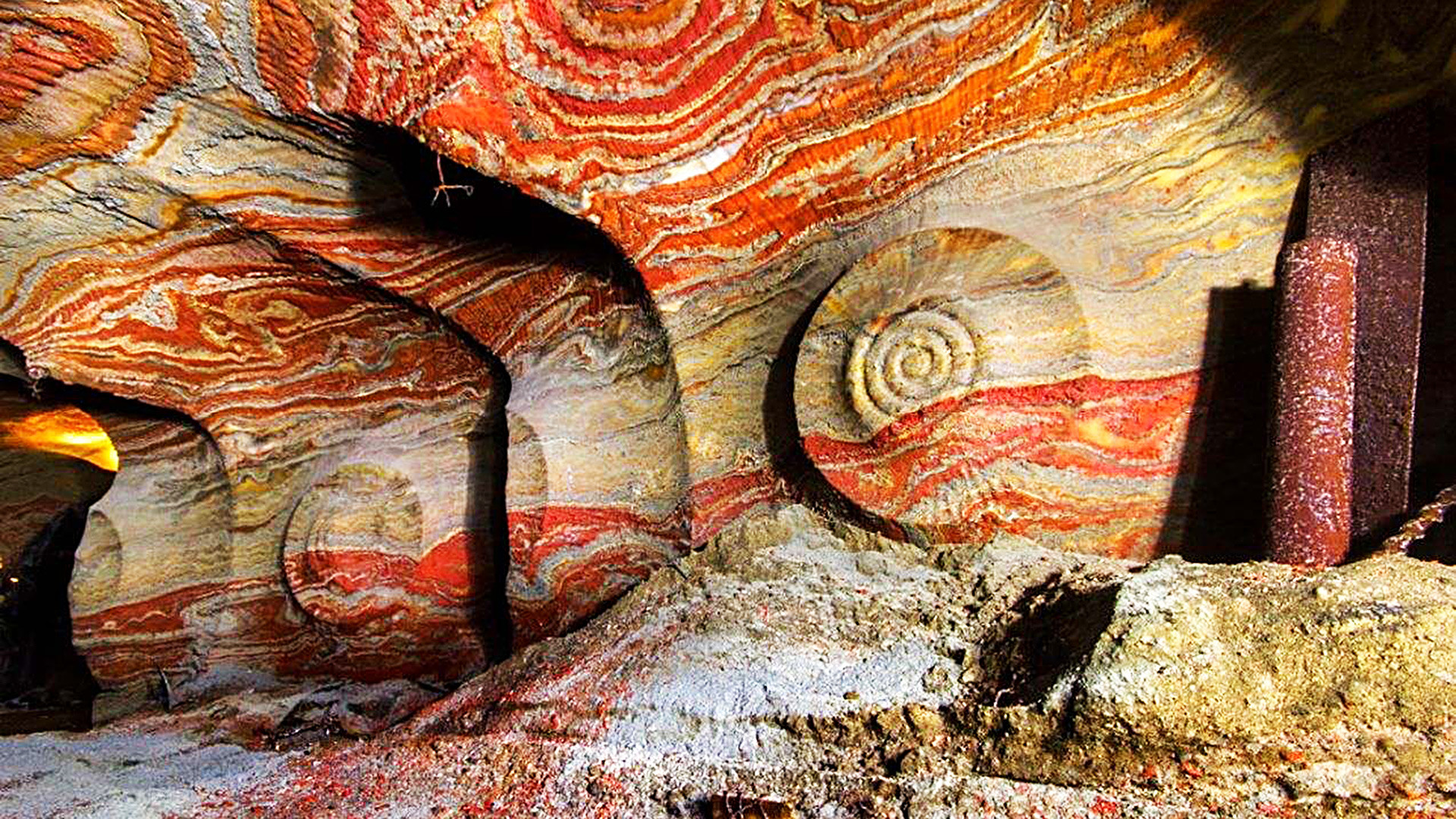
Online commentators have been comparing these Yekaterinburg salt mines to a psychedelic nightclub, calling for the city’s raves to move (perhaps a little too literally) underground.
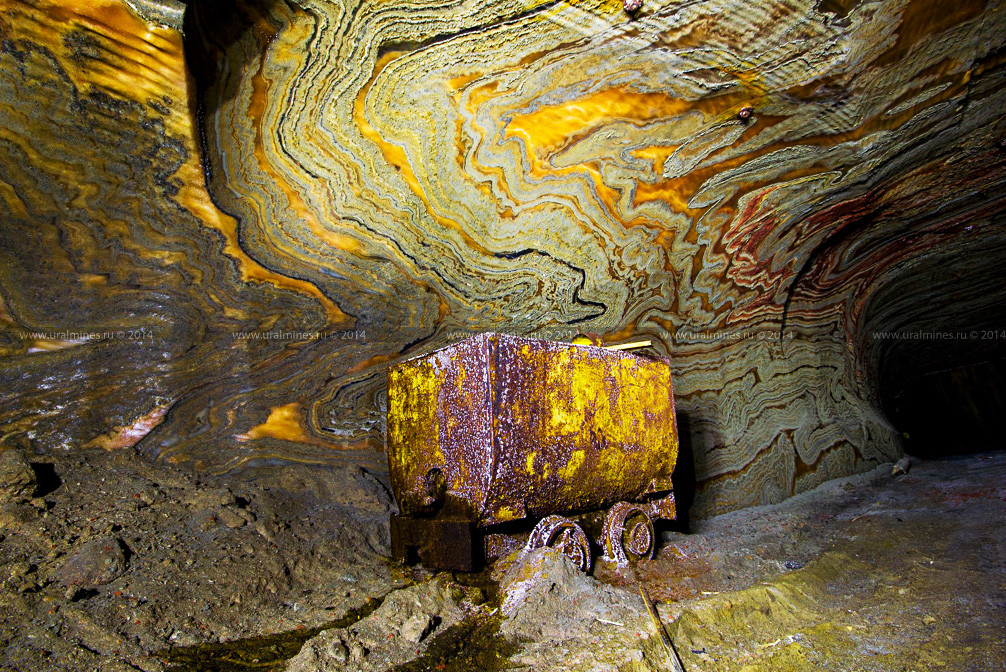
These surreal mines, 650 feet below the Ural city (600 miles east of Moscow), look like they were designed by Vincent Van Gogh, or could perhaps even be mistaken for murals from an ancient civilization.
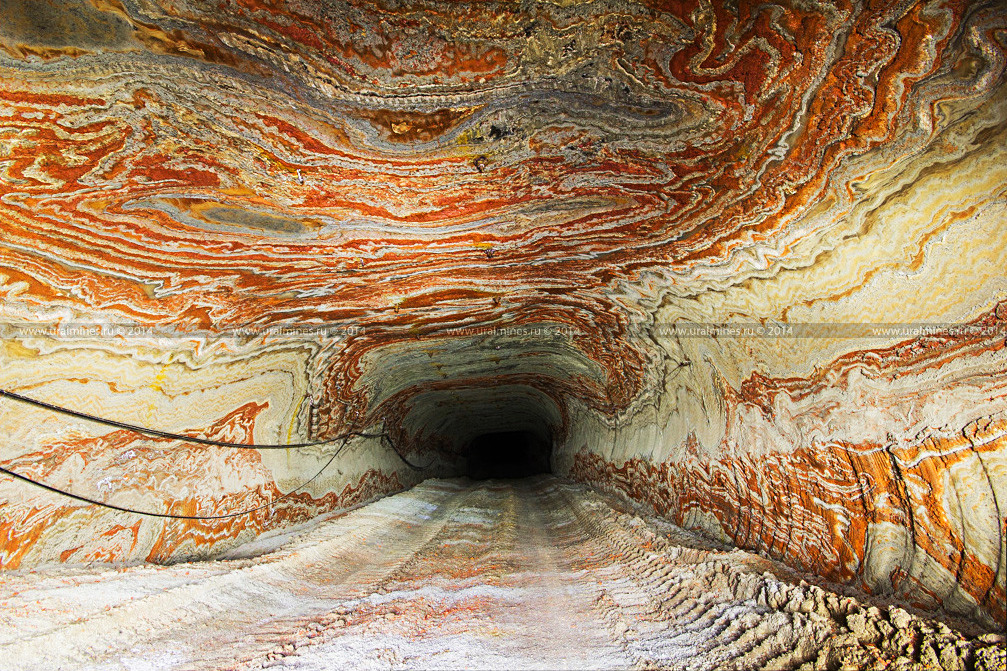
However, the phenomenal kaleidoscopic effect is completely natural. A saltwater sea, long since evaporated, formed the colors during the Permian era (280 million years ago), leaving layers of rich, vivid mineral deposits behind.
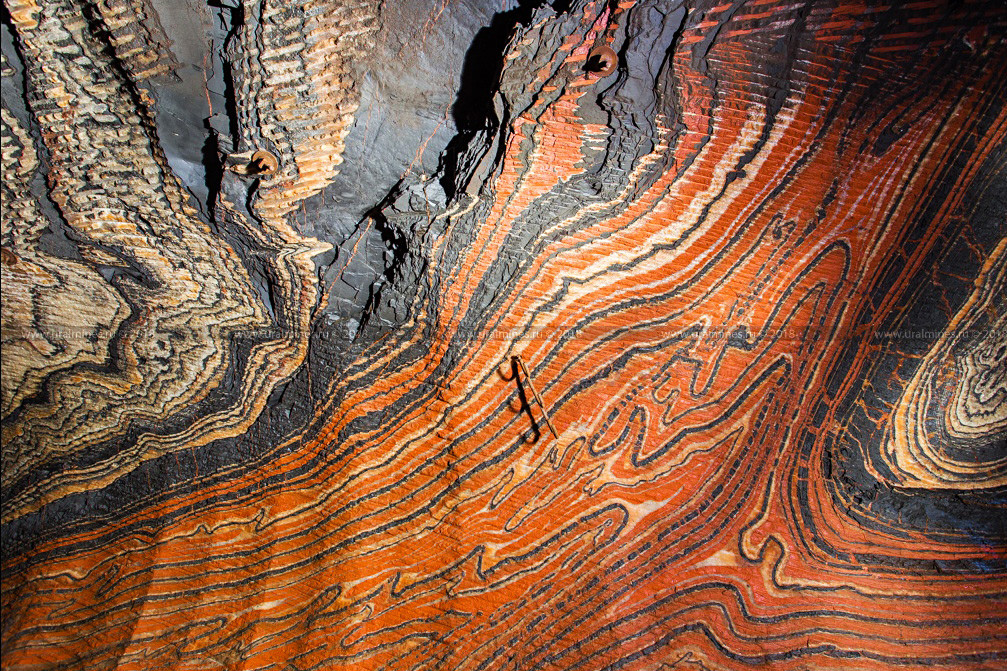
The colors are mainly a result of dried carnallite and potassium magnesiates, used today as fertilizers. The effect takes a wide range of hues and forms including red, white, azure, and gold concentric circles and waves.
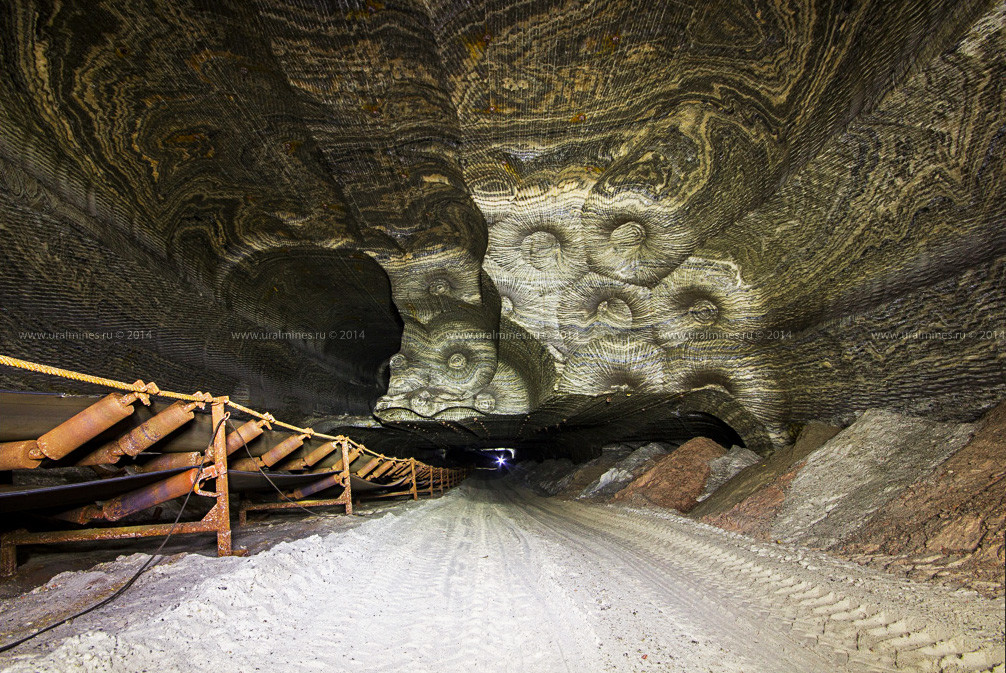
Photographer Mikhail Mishainik stumbled upon these incredible mines in 2014, when he spent days and nights exploring them, despite the high risk of gas leaks and landslides.
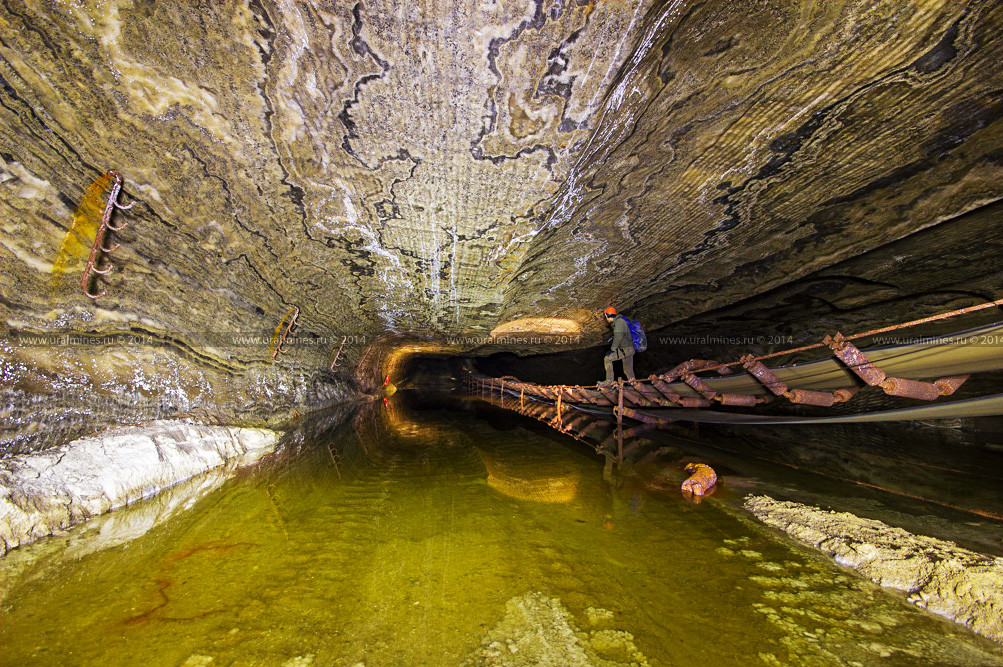
According to Mikhail, the labyrinth of tunnels can stretch for miles. He says the air is very dry - because of the high levels of salt in the mine.
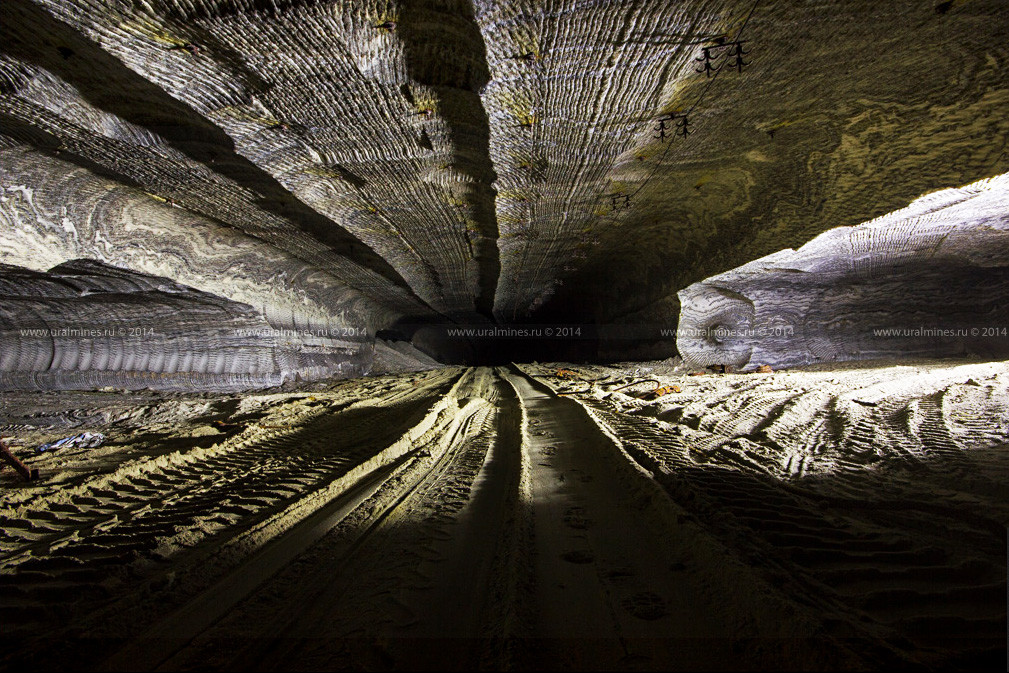
So why did the artistic potential of these mines go unnoticed for so long? It might have something to do with the lighting: the mines are pitch black, and the full glory of the vibrant walls are only revealed under very strong torchlight.
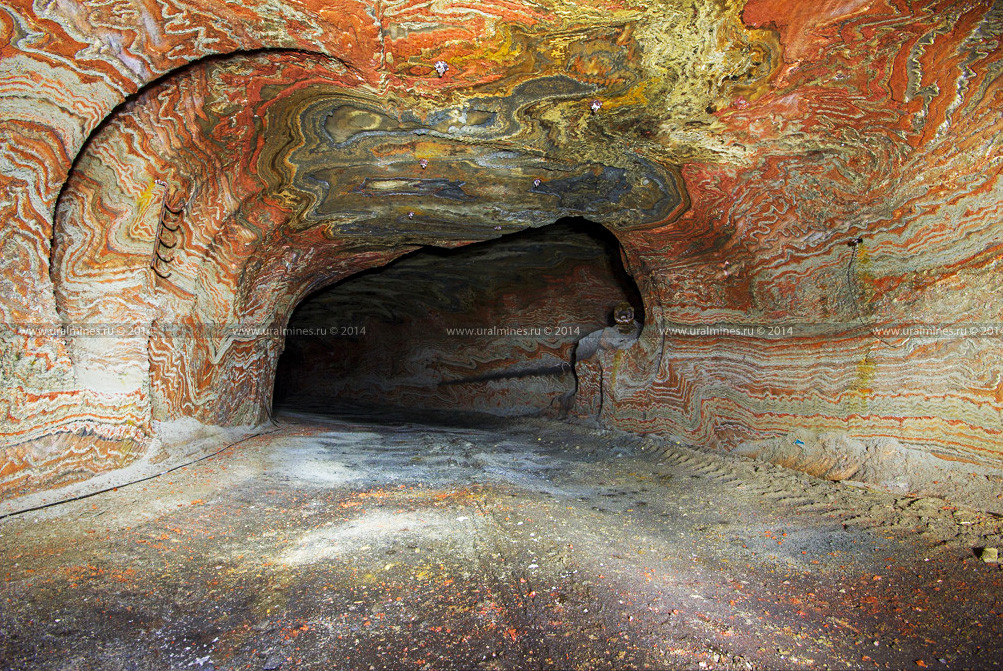
Some of the tunnels are still in use, though most are now inactive and can only be entered with a government permit. Sadly, that means we might have to wait a while for the first techno night here.
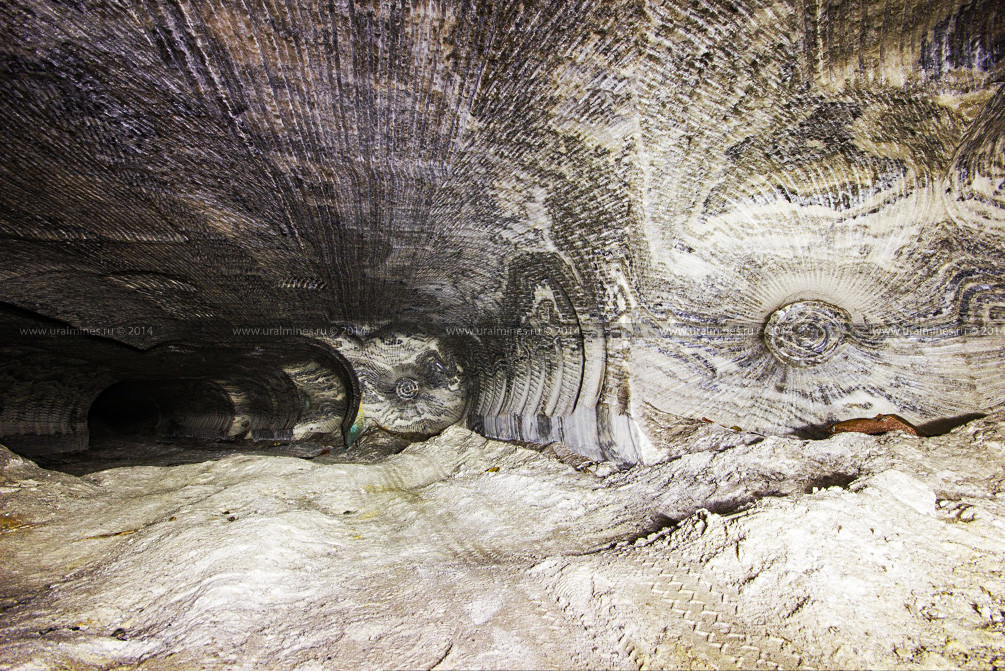
Russians are well known for their extreme exploration feats: just ask any roofer or digger . Salt mining might just be the most visually spectacular adventure to date.
If using any of Russia Beyond's content, partly or in full, always provide an active hyperlink to the original material.
to our newsletter!
Get the week's best stories straight to your inbox
- Why did Russia’s tsars love Lake Elton?
- 8 natural wonders in Russia that are (relatively) easy to reach (PHOTOS)
- 6 superstitious spots in Moscow that’ll cure your problems, from being broke to infertility
- 4 middle-of-nowhere Siberian places that somehow got English names
This website uses cookies. Click here to find out more.

IMAGES
VIDEO
COMMENTS
Detroit salt mine worker (Detroit Salt Company) The mine remained in use until 1983, when International Salt closed the doors. Two years after the closure in 1985, Crystal Mines Inc. purchased the ...
Six men were killed during the dig, and the Detroit Salt and Manufacturing Company was bankrupted in the process. The 1,060-foot shaft was finally completed in 1910. A second tunnel was dug in ...
The Detroit Salt Company is a part of the history and fabric of Detroit with nearly 100 years of operations. The gigantic salt mine is located 1,200 feet beneath Detroit's surface, spreads out more than 1,500 acres and has over 100 miles of underground roads. The mineshaft opening is located at 12841 Sanders Street in Detroit, Michigan.
Years the salt mine was abandoned, from 1983-1998. The economy of salt mining dried up like a 400 million-year-old ocean, prompting the company at the time, International Salt, to say, "Na."
Detroit salt mine. Coordinates: 42.2858°N 83.1497°W. The Detroit salt mine is a salt mine located 1,100 ft (340 m) below Detroit, Michigan. [1] The mine opened in 1910 and covers 1,500 acres (610 ha) underground. [2] In the beginning, the leather and food industries were the primary customers. Today, road deicing salt is the primary product.
In 1997, the Detroit Salt Company, LLC, purchased the mine from Crystal Mines, Inc. and began salt production in the fall of 1998. Although the leather and food industries were once large customers to the Detroit mine, road deicing salt is the only product the mine currently provides. The Detroit Salt Company, LLC, employs the latest mining ...
The existence of rock salt in the Detroit area was discovered in 1895, and the difficult and expensive work of digging a mine shaft began in 1906. The original company went bankrupt before any ...
While walking through downtown Detroit, visitors and tourists are rarely aware that beneath their feet lies a massive expanse of tunnels and, essentially, an underground metropolis spanning 1,500 acres with over 100 miles of roads. Known as one of the largest salt deposits and the most spectacular salt mines in the world, the Detroit salt mines are central to the city's economy and culture ...
The Detroit Salt Company, LLC, has owned and operated Michigan's only rock salt mine since 1997. This privately held business was acquired by The Kissner Group in 2010 and is as rooted in southeast Michigan as the mine itself. The mine is a thriving Detroit business, supplying its local and national customers with tons of rock salt and ...
A new company, Detroit Rock Salt Company, took over the excavation and completed the job in 1910. The struggle to complete the 1,060 shaft was one of the most impressive engineering feats of its time. By 1925, a competing salt mining company, International Salt, purchased the mine and a second, larger shaft, was dug.
Detroit History Tours invites you to share in those incredible tales of adventure, experimentation, activism, showmanship, and pure Detroit gumption. Allow us to be your guide to the hidden history of our beautiful city. Whether you are a born and raised Tigers fan or brand new to the Motor City our in-depth, highly researched, expert led tours ...
January 24, 2011. 1923 If you doubt that metro detroiters are "the salt of the earth," just look down — about 1,200 feet. In the city's cellar are more than 1,400 acres of a salt mine, remnants of what was a sea millions of years ago. The men wearing headlamps here are using pickaxes to hack at salt rocks. The mineshaft's opening is ...
1,200 feet under Detroit is a huge, giant, insanely big salt mine. The mine sprawls across 1,500 acres and contains more than 100 miles of road. instagram facebook twitter yelp youtube
Rock salt was discovered in Detroit in 1895, but it wasn't until 1906 that the Detroit Salt and Manufacturing Company began the arduous task of digging a shaft to create a mine. Despite many challenges, a bankruptcy and business reorganization, the shaft was completed by the newly named Detroit Salt Company. In 1912, under the name Detroit ...
Thanks to the generosity of the Detroit Salt Company, and the organizing efforts of Lodge No. 7 member Malcolm "Mac" McAdam, this group was given the rare opportunity to tour the mine of the Detroit Salt Company on Saturday, June 26, 2010. The tour also served as a fund-raiser for the ISMA Grand Lodge Scholarship Fund.
How Detroit Salt Company Mines. Approximately 1,000 feet of rock lie atop the vein of salt. To safely extract the salt from the deep deposits, Detroit Salt Company employs the "room and pillar" system. This method creates massive pillars, which support the mine roof and the overburden separating the mine from the surface. Parallel galleries ...
Over 1,000 feet beneath the city of Detroit is a 1,500 acre sprawl of tunnels created by salt miners at the turn of the twentieth century. Over at Environmental Graffiti, there's a fascinating ...
Private Eagle's Nest and Salt Mines Tour from Salzburg. Historical Tours. from. $299.04. per adult (price varies by group size) The area. Bergwerkstrasse 83, 83471 Berchtesgaden, Bavaria Germany. Reach out directly. Visit website.
Detroit Free Press. 0:00. 0:59. Detroiters on Friday get their first look inside revived Michigan Central Station after Thursday's blowout opening night concert. Visitors, who had to sign up in ...
The words "Russian salt mine" don't usually make you think of stunning images. Unless, of course, you've seen a sylvinite mine. Sylvinite is a mixture of rock and potassium-bearing salts ...
Detroit Salt Mine Formation. How did the salt get there in the first place? Michigan, in geologic terms, is a basin - a large area of lower elevation than surrounding areas. 400 million years ago, scientists believe this area was filled with salty sea water, much like the Great Salt Lake in Salt Lake City, Utah. Through several climate changes ...
662. Abandoned salt mine. Mikhail Mishainik/Caters News. All the loud beats and techno lights in Moscow on a Saturday night don't hold a flame to the mind-bending natural formations found 650 ...
About 60,000 people claimed tickets for 10 days of public tours of the 1913-built depot that closed in 1988 and has undergone a six-year renovation.
These surreal mines, 650 feet below the Ural city (600 miles east of Moscow), look like they were designed by Vincent Van Gogh, or could perhaps even be mistaken for murals from an ancient ...